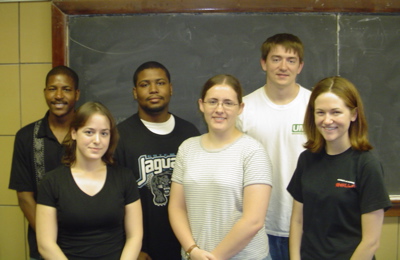Missouri Miners
From 2007.igem.org
(→A biological breathalyzer) |
|||
| (8 intermediate revisions not shown) | |||
| Line 1: | Line 1: | ||
| + | ==[http://www.umr.edu University of Missouri-Rolla] [[Image:Joe_Miner_Logo.JPG]] Miners iGEM Team == | ||
| + | |||
We have two projects for the summer: | We have two projects for the summer: | ||
| - | + | ===A biological timer=== | |
| - | + | ||
| - | + | To participate in the iGEM competition, we plan to make a timer from a synthetic genetic circuit. Past iGEM | |
| - | + | designs of clocks have been successful, so we decided to build on this idea. Our idea is to fashion a genetically | |
| - | + | modified network within E. coli cells which is regulated by and input signal, and emits an output, or “off” signal | |
| + | after a given amount of time. The input for the circuit will be a specific amount of arabinose and the output will | ||
| + | be fluorescence. The bacteria, which will continually synthesize GFP, will be fed an input signal of arabinose | ||
sugar. During consumption of the sugar, the GFP production will be repressed. This hiatus in the fluorescence | sugar. During consumption of the sugar, the GFP production will be repressed. This hiatus in the fluorescence | ||
signifies a timed period. Upon complete consumption of the sugar, the bacteria will once again actively generate | signifies a timed period. Upon complete consumption of the sugar, the bacteria will once again actively generate | ||
GFP, signaling that time is up and the timer is off. The amount of arabinose fed to the cells will determine the | GFP, signaling that time is up and the timer is off. The amount of arabinose fed to the cells will determine the | ||
amount of time it takes for them to fluoresce. | amount of time it takes for them to fluoresce. | ||
| - | |||
| + | This timer device will be created as an individual “machine,” independent of a larger network or device. We are | ||
| + | curious to discover if construction of such a device is possible before we try to integrate it into a larger | ||
| + | system. Additionally, we plan to add at least one new BioBrick part to the parts registry for future use. In June | ||
| + | we began the process of choosing and replicating four different BioBricks necessary for our device. | ||
| + | |||
| + | ===A biological breathalyzer=== | ||
| + | |||
| + | The purpose of this research is to use recombinant technology to culture yeast cells capable of determining the concentration of ethanol and using these cells to construct a breathalyzer. A complex pathway for the metabolism of methanol exists within some species of the ''Pichia'' genus. Alcohol oxidase (AO) appears to be the first and major enzyme produced in this metabolic pathway (1). Transcribed from its gene (AOX1), AO converts methanol to formaldehyde within the yeast’s peroxisome (1). A metabolic pathway for the utilization of ethanol is also present within the yeast. However, if both ethanol and methanol is present, the yeast will utilize the ethanol before consuming the methanol (2). Consequently, the AOX1 gene will not be expressed to produce the AO enzyme until the ethanol has been consumed. | ||
| + | |||
| + | Fusing the AOX1 gene promoter with the DNA sequence of a fluorescent protein will allow the expression from the AOX1 promoter to be detected. In supplying the yeast cells with ethanol and methanol simultaneously, the cells will produce the fluorescent protein once the ethanol is utilized; resulting in a fluorescent light. The concentration of ethanol can be determined by measuring the time before a fluorescent light is emitted. | ||
| + | |||
| + | Determining the concentration of ethanol present will also make plausible the construction of a breathalyzer device to determine the blood alcohol level in an individual. Constructing a biological breathalyzer will require various interdisciplinary skills to accomplish. Biological techniques are required to construct, amplify, and introduce the vector containing the fused DNA sequences into the yeast cells. Knowledge of the biochemical reactions is needed to understand the ethanol and methanol metabolic processes to manipulate the yeast cells to produce a visual response to ethanol. An engineering approach is necessary to design and construct the device so as to introduce methanol once the ethanol has been supplied by the individual, as well as determining and displaying the blood alcohol level. | ||
| + | |||
| + | 1. Cregg, James M., K. R. Madden, K. J. Barringer, G. P Thill, and C. A. Stillman. 1989. Functional Characterization of the Two Alcohol Oxidase Genes from the Yeast Pichia pastoris. Molecular and Cellular Biology. 9:1316-1323. | ||
| + | |||
| + | 2. Inan Mehmet and Michael M. Meagher. The Effect of Ethanol and Acetate on Protein Expression in Pichia pastoris. 2001. Journal of Bioscience and Bioengineering. 9: 337-341. | ||
| + | |||
| + | ==iGEM team== | ||
| + | |||
| + | ===Students=== | ||
| + | [[Image:iGEMteam.JPG]] | ||
| - | + | left to right: Cory, Rachel, Herman, Amber, Morgan, Jackie | |
Latest revision as of 14:25, 12 September 2007
Contents |
[http://www.umr.edu University of Missouri-Rolla]  Miners iGEM Team
Miners iGEM Team
We have two projects for the summer:
A biological timer
To participate in the iGEM competition, we plan to make a timer from a synthetic genetic circuit. Past iGEM designs of clocks have been successful, so we decided to build on this idea. Our idea is to fashion a genetically modified network within E. coli cells which is regulated by and input signal, and emits an output, or “off” signal after a given amount of time. The input for the circuit will be a specific amount of arabinose and the output will be fluorescence. The bacteria, which will continually synthesize GFP, will be fed an input signal of arabinose sugar. During consumption of the sugar, the GFP production will be repressed. This hiatus in the fluorescence signifies a timed period. Upon complete consumption of the sugar, the bacteria will once again actively generate GFP, signaling that time is up and the timer is off. The amount of arabinose fed to the cells will determine the amount of time it takes for them to fluoresce.
This timer device will be created as an individual “machine,” independent of a larger network or device. We are curious to discover if construction of such a device is possible before we try to integrate it into a larger system. Additionally, we plan to add at least one new BioBrick part to the parts registry for future use. In June we began the process of choosing and replicating four different BioBricks necessary for our device.
A biological breathalyzer
The purpose of this research is to use recombinant technology to culture yeast cells capable of determining the concentration of ethanol and using these cells to construct a breathalyzer. A complex pathway for the metabolism of methanol exists within some species of the Pichia genus. Alcohol oxidase (AO) appears to be the first and major enzyme produced in this metabolic pathway (1). Transcribed from its gene (AOX1), AO converts methanol to formaldehyde within the yeast’s peroxisome (1). A metabolic pathway for the utilization of ethanol is also present within the yeast. However, if both ethanol and methanol is present, the yeast will utilize the ethanol before consuming the methanol (2). Consequently, the AOX1 gene will not be expressed to produce the AO enzyme until the ethanol has been consumed.
Fusing the AOX1 gene promoter with the DNA sequence of a fluorescent protein will allow the expression from the AOX1 promoter to be detected. In supplying the yeast cells with ethanol and methanol simultaneously, the cells will produce the fluorescent protein once the ethanol is utilized; resulting in a fluorescent light. The concentration of ethanol can be determined by measuring the time before a fluorescent light is emitted.
Determining the concentration of ethanol present will also make plausible the construction of a breathalyzer device to determine the blood alcohol level in an individual. Constructing a biological breathalyzer will require various interdisciplinary skills to accomplish. Biological techniques are required to construct, amplify, and introduce the vector containing the fused DNA sequences into the yeast cells. Knowledge of the biochemical reactions is needed to understand the ethanol and methanol metabolic processes to manipulate the yeast cells to produce a visual response to ethanol. An engineering approach is necessary to design and construct the device so as to introduce methanol once the ethanol has been supplied by the individual, as well as determining and displaying the blood alcohol level.
1. Cregg, James M., K. R. Madden, K. J. Barringer, G. P Thill, and C. A. Stillman. 1989. Functional Characterization of the Two Alcohol Oxidase Genes from the Yeast Pichia pastoris. Molecular and Cellular Biology. 9:1316-1323.
2. Inan Mehmet and Michael M. Meagher. The Effect of Ethanol and Acetate on Protein Expression in Pichia pastoris. 2001. Journal of Bioscience and Bioengineering. 9: 337-341.
iGEM team
Students
left to right: Cory, Rachel, Herman, Amber, Morgan, Jackie
